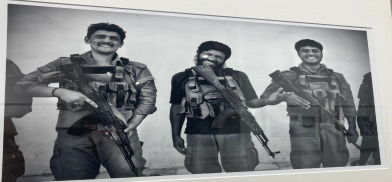How the world failed Afghanistan: Three years since the Taliban's return to power
When the world descended on Afghanistan in 2001, Afghans believed it was about them, about a better life for them. It never was. It never is, writes senior reporter Kathy Gannon, who has covered Afghanistan since the 1980s. Looking back at the second Taliban takeover in 2021 she looks at why the ironically named ‘Operation Enduring Freedom’ of 2001 failed and how the aspirations of Afghans have been ignored.

The anniversary of the Taliban’s 2021 takeover brought to mind those searing images of that American C-17 aircraft taking off, despite the human beings clinging to its wings, doors and wheel well, reminding me of just how little successive foreign interventions have been about Afghans, their wellbeing and prosperity.
On Tuesday 13 August, the Taliban celebrated the anniversary at a ceremony at Bagram Air Base north of the Afghan capital Kabul.That same Bagram base was once the epicenter of America’s 2001 Afghan invasion known as Operation Enduring Freedom – in hindsight a poor name choice.
While analysts and experts used the anniversary to offer their thoughts on Afghanistan’s past, present and some to speculate on the future, I was reminded of 24-year-old Fida Mohammad, and 17-year-old Zaki Anwari.
Fida and Zaki
Fida was a newly married dentist from nearby Parwan Province and Zaki was just 17 years old, an up-and-coming soccer star – or so he thought. Both were among the many Afghan men, and boys, who descended on Kabul International Airport on Aug. 16, 2021 – one day after the Taliban’s return.
The U.S., NATO and just about every embassy were scrambling to get out of town. The United Nations to its credit stayed.
Unlike the foreigners, Fida and Zaki were there like most every Afghan there, not because they were afraid of the new Taliban rulers, but because they saw no future in their country.
In a desperate, unthinking moment Fida grabbed on to the wheels of the departing aircraft. He fell to his death when the pilot retracted the landing gear.
Zaki was running alongside the aircraft when he slipped to his right and was crushed to death by the departing C-17.
To my mind their deaths symbolize all that Operation Enduring Freedom failed to deliver for Afghanistan’s 40 million people, who embraced the intervention at its outset in 2001, including most former Taliban. Many would later return to the Taliban.
Fida had been married less than a year, but his wedding had been costly. His father had sold his share in a convenience store to his brother for the equivalent of about $13,000. It was a huge amount, but Fida was his first born and the first to marry. He hoped to one day repay his brother and reclaim his share in the small business.
Fida made little money and struggled with the financial burden his wedding had placed upon his father. His father said he never knew just how much Fida worried, until he came to know his son was among the Afghan men and boys killed hoping to reach America aboard that C-17 aircraft.
But when the C-17 ascended over the Kabul outskirts and the pilot retracted the wheels, Fida and another young Afghan man became tiny black specks in the sky as they plummeted to the ground. The second young Afghan was later identified by local media as Safiullah Hotak.
They must have been holding hands, speculated Abdullah Waiz the man on whose small rooftop the two men fell, their mutilated bodies barely recognizable. “Otherwise, how could they have landed in the same small corner?” Waiz collected their remains and took them to a nearby mosque.
Fida was identified from a small piece of paper he had stuffed in his pocket. On it was written the name and phone number of his father.
His father believed his son made his tragic attempt to board the C-17 in hopes of getting to America to earn enough money to pay him back.
The desire of Afghans to flee their country in search of a better life most certainly was heightened by the Taliban’s return, as well as the mass exodus of the frightened foreigners, but it wasn’t new.

Unemployment
In 2019 when neighbour Pakistan – a country most Afghans don’t even like – opened its Consulate in the eastern city of Jalalabad for visas, Afghans mobbed the building. Nine people died in the crush for visas. That was two years before the Taliban returned to Kabul and 18 years after the start of Operation Enduring Freedom.
At the time unemployment hovered around 40 percent, and more than half the population lived below the poverty level.
Zaki, on the other hand, wasn’t born when the Taliban last ruled but he had heard stories. To his ears the worst of the stories was about the Taliban’s previous loathing of sports, particularly soccer.
As an up-and-coming star on Afghanistan’s national team, Zaki feared his dreams of competing internationally ended with their return, said his older brother.
Zaki would spend hours watching his hero Lionel Messi play. “He couldn’t get enough. It was all he talked about, all he did,” according to his brother.
When Zaki went to the airport that morning his social media feeds were on fire with reports that anyone getting to the airport could get to America. He was supposed to stay in the car with a cousin, who had worked for an American company. tried to enter the airport.
Instead, he jumped the wall and in a frantic last-minute call to his mother he told her “I am going to America.”
Today Afghanistan is barely on the U.S. radar, but for the Taliban’s stubborn refusal to let girls go to school beyond Grade 6, and the presence on its soil of a cacophony of militant groups.
But today I still can’t help but think of Fida and Zaki and how, like so many of Afghanistan’s 40 million people, Operation Enduring Freedom, let them down. When the world descended on Afghanistan in 2001, Afghans believed it was about them, about a better life for them.
It never was. It never is.
(The author is a former correspondent and bureau chief for the Associated Press in Pakistan and Afghanistan. She and photographer Anja Niedringhaus were the first western journalists to embed with the Afghan army. First published on author's Substack.https://kathygannon.substack.com/p/three-years-since-the-taliban-takeover By special arrangement with Sapan).
casino en ligne
You've made your point extremely nicely..
casino en ligne
Cheers, Helpful stuff.
casino en ligne France
You actually stated that superbly!
casino en ligne francais
Nicely put, Appreciate it!
casino en ligne France
This is nicely said. .
casino en ligne
Many thanks. I enjoy this!
casino en ligne francais
Cheers, I like it.
casino en ligne
You said it exceptionally well!
casino en ligne
Nicely put. Thanks!
casino en ligne fiable










Post a Comment